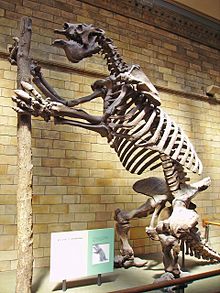Megatheriinae
| Megatheriinae Temporal range: Early Miocene to Early Holocene (Hemphillian-Rancholabrean (NALMA) & Santacrucian-Lujanian) (SALMA)
| |
|---|---|

| |
| Megatherium americanum skeleton, Natural History Museum, London | |
| Scientific classification | |
| Domain: | Eukaryota |
| Kingdom: | Animalia |
| Phylum: | Chordata |
| Class: | Mammalia |
| Order: | Pilosa |
| Family: | †Megatheriidae |
| Subfamily: | †Megatheriinae Gill, 1872 |
| Genera | |
Megatheriinae is a subfamily of the Megatheriidae, an extinct family of ground sloths that lived from the Middle Miocene to the Early Holocene.[2][3]
Classification[edit]
Within the Megatheriidae there are two (possibly three) subfamilies; the Megatheriinae and the Planopsinae. The phylogenetically older group is represented by the Planopsinae from the Lower and Middle Miocene. These still possessed a caniniform anterior tooth, which was separated from the posterior molar-like teeth by a small diastema . The more derived Megatheriinae, which are known from the Middle Miocene to the Early Holocene, on the other hand, had fully homodontic molars in a closed row.[4] Originally, the subfamilies of the Nothrotheriinae and the Schismotheriinae were also placed in the Megatheriidae.[5] Based on skull studies, the Nothrotheriidae, in which, among other genera, Nothrotherium, Nothrotheriops, and the semiaquatic Thalassocnus are placed, are regarded as a separate family, which forms the sister group of the Megatheriidae.[6]
References[edit]
- ^ Rincón, Ascanio D.; Valerio, Ana L.; Laurito, César A.; Rincón, Ascanio D.; Valerio, Ana L.; Laurito, César A. (June 2020). "First fossil record of a Megatheriidae-Megatheriinae in the Early Hemphillian (Late Miocene) from San Gerardo de Limoncito, Curré Formation, Costa Rica". Revista Geológica de América Central (62): 1–24. doi:10.15517/rgac.v62i0.41278 (inactive 31 January 2024). ISSN 0256-7024.
{{cite journal}}: CS1 maint: DOI inactive as of January 2024 (link) - ^ Luliis, Gerardo De (1996). A systematic review of the Megatheriinae (Mammalia: Xenarthra Megatheriidae) (Thesis).
- ^ Varela, Luciano; Tambusso, P Sebastián; McDonald, H Gregory; Fariña, Richard A (2018-09-15). "Phylogeny, Macroevolutionary Trends and Historical Biogeography of Sloths: Insights From a Bayesian Morphological Clock Analysis". Systematic Biology. 68 (2): 204–218. doi:10.1093/sysbio/syy058. ISSN 1063-5157. PMID 30239971.
- ^ Carlini, Alfredo A.; Brandoni, Diego; Dal Molin, Carlos N. (2013). "A new genus and species of Planopinae (Xenarthra: Tardigrada) from the Miocene of Santa Cruz Province, Argentina". Zootaxa. 3694 (6): 565–578. doi:10.11646/zootaxa.3694.6.4. hdl:11336/18925. ISSN 1175-5326. PMID 26312311.
- ^ McKenna, Malcolm C.; Bell, Susan K. (1997-10-17). Classification of Mammals: Above the Species Level. Columbia University Press. ISBN 978-0-231-52853-5.
- ^ Gaudin, T. J. (2004). "Phylogenetic relationships among sloths (Mammalia, Xenarthra, Tardigrada): The craniodental evidence". Zoological Journal of the Linnean Society. 140 (2): 255–305. doi:10.1111/j.1096-3642.2003.00100.x.


